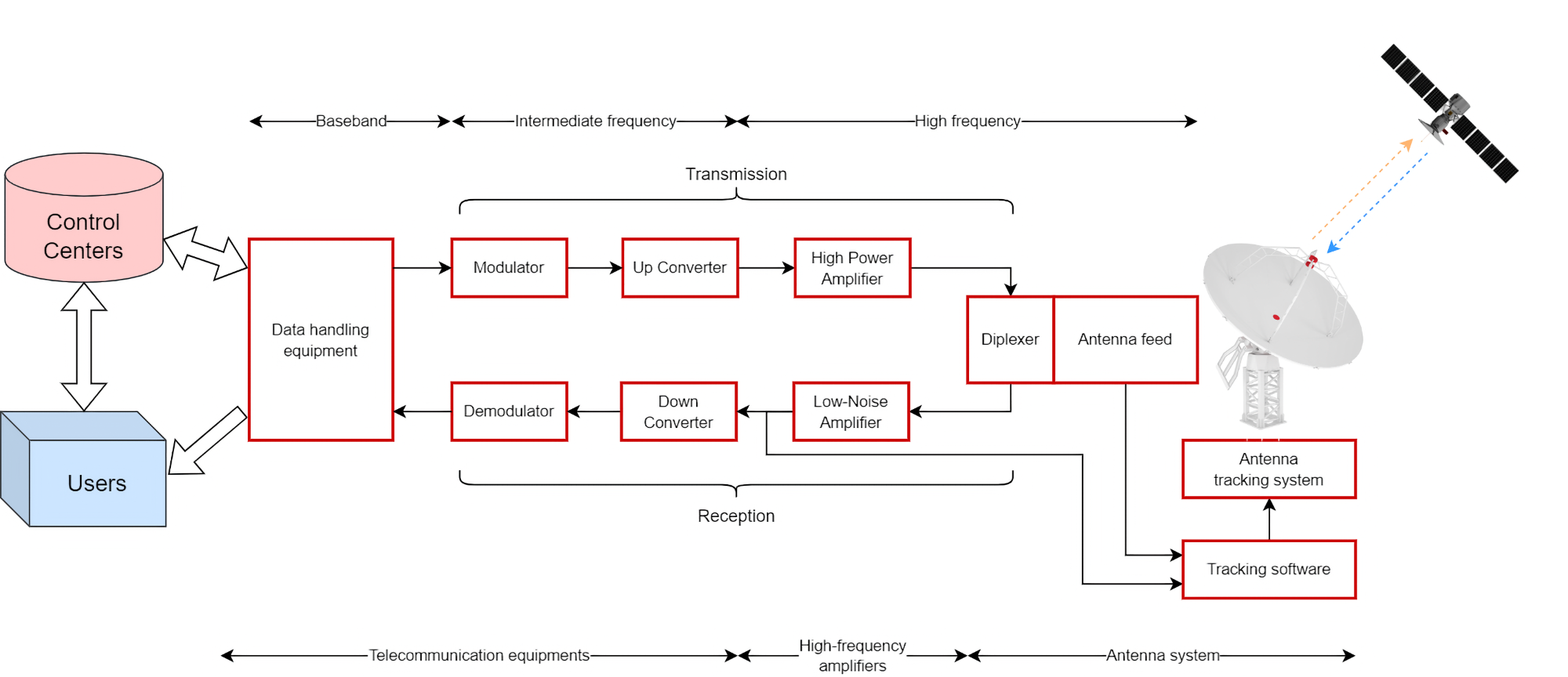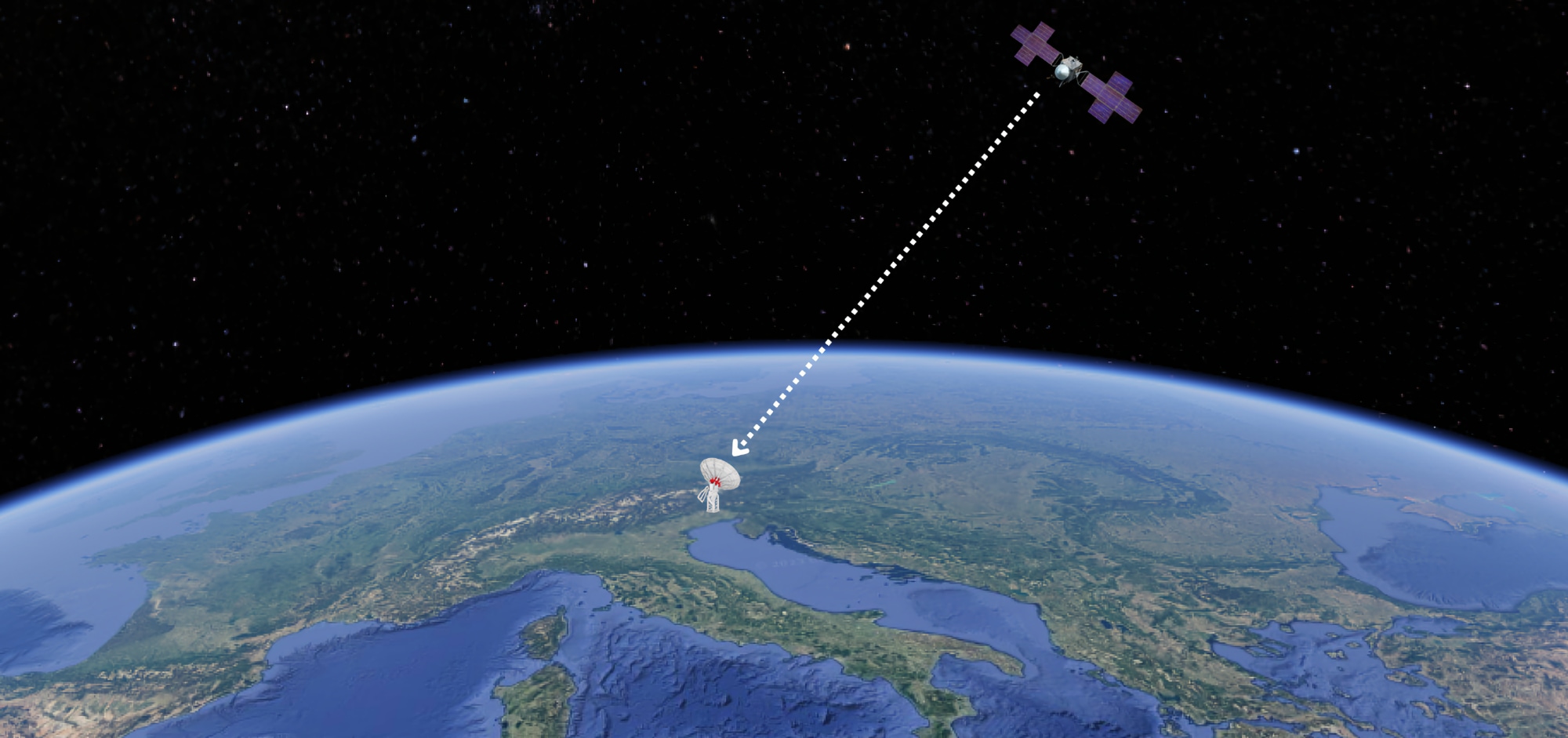Ground station for space communication is a crucial component of ground segment, serving as terrestrial infrastructure that establish communication link with satellites in orbit or deep-space missions to complement and support its operations. A ground station is a key element within the ground segment, being the communication hub between Earth and satellites. Typically equipped with sophisticated antennas, receivers and transmitters, a ground station acts as a bridge, facilitating the flow of information that enables satellite data acquisition, control, and the transmission of valuable payloads. Main functions of ground segment:
• Supporting the spacecraft and payload:
– To maintain RF communication
– To track spacecraft
– To process information
– To determine orbit, position, and velocity of spacecraft
– To command and control payload and spacecraft
• Interfacing with users:
– To provide them with requested data
– To receive any control requests
Ground system consists of ground stations and control centers, working together to support spacecraft and users. It commands and controls spacecraft based on user requests at control center.
• Ground stations: acquire data from spacecraft and transfer this data to users, providing them with all necessary informations.
• Control centers: make mission decisions, handling both user interface and managing interface with space segment.
Data handling equipments include networks interfaces, multiplexing/demultiplexing equipments and signal processing devices dedicated to managing information related to telemetry, mission data, and commands. Multiple signals at different frequencies can arrive simultaneously to a ground station, as is the case with GEO satellites, and information extraction must be done for each one. For this reason, multiple (and redundant) modulators and demodulators with their respective up-converters and down-converters are needed also to address malfunctions or manage complexities associated with certain satellites. Converters are devices used to perform a frequency translation of the signal to facilitate its amplification. Subsequently, they are combined into a single signal with a dedicated combiner and amplified by an high power amplifier, reaching the diplexer and finally the antenna, which transmits them. The reverse process occurs similarly during data reception.

How does a ground station for space communications work? Block diagram of a ground segment with ground station.
Ground Station for space communication
One of the primary functions of a ground station is to establish and maintain communication with satellites orbiting the Earth or in deep space: this involves tracking their trajectories, ensuring precise pointing of antennas, and compensating for the dynamic nature of orbital mechanics. Ground stations are strategically located to provide continuous coverage, allowing for seamless communication as satellites move across the sky. Moreover, they are equipped with advanced tracking systems and communication protocols to optimize signal reception and transmission. These systems are designed to mitigate challenges such as atmospheric interference, signal degradation, and the effects of Earth’s rotation, ensuring reliable and high-quality communication with satellites.
In addition to real-time communication, ground stations play a vital role in data reception and distribution. They receive and process the information transmitted by satellites, including telemetry, scientific data, and imagery. This data is then disseminated to relevant end-users, mission control centers, or processing facilities for further analysis and utilization.
Depending on the satellite’s passage, it is necessary to accurately point the antennas. To achieve this, antennas are equipped with feedback control systems. These systems determine the desired orientation, compare it with the current orientation, and activate motors to move the antenna and correct any errors, adjusting both elevation and azimuth angles. This is a closed-loop control system, involving sensors to measure the antenna’s orientation, a control unit defining the desired position moment by moment, and a control component with actuators moving the antenna. To determine the desired orientation, it is necessary to establish the satellite’s location using specialized software. Orbital propagators, mathematical models that track satellites and, through ephemerides, estimate satellite positions, are employed for this purpose. These models calculate the optimal pointing by defining at every instant when the satellite comes into visibility of the station.
Two Line Elements (TLE)
Typically, starting from Two Line Elements (TLE), which are provided daily, propagators are used to determine when the satellite enters the visibility of the ground station, moment by moment. Once this is known, azimuth and elevation commands are then determined for the antenna tracking system to orient it accurately. TLE set is a data format used to describe the orbital parameters of an Earth-orbiting satellite and other space object (like space debris monitoring) for a given epoch. Using an appropriate prediction formula, the position and velocity at any point in the past or future can be estimated to some accuracy. The typical format includes two lines, summarizing the orbital parameters of a satellite:
• LINE 1: general information, such as the satellite number, the International Designator (an ID assigned to artificial objects in space), the specific time, and certain orbital parameters like the inclination, the right ascension and the eccentricity.
• LINE 2: further orbit details, including the argument of perigee, the mean anomaly, the average angular speed (mean motion) and the revolution number at epoch.
These elements need to be updated to account for changes in a satellite’s orbit caused by various perturbations like gravity gradient and atmospheric drag.

How does a ground station for space communications work? Depending on the satellite’s passage, it is necessary to accurately point the ground station antenna.
INTREPID ground station for space communication
If you’re looking for a ground station for radio frequency space communications, consider opting for our INTREPID ground station antenna systems. These ground stations include a specially designed antenna tracking system to automatically track satellites based on TLE. Explore all the available models of our INTREPID ground station for space communication by clicking here. We provides comprehensive services, including design, shipment, installation, and training. From conceptualization to on-site training, we are here to support every phase of your mission.
